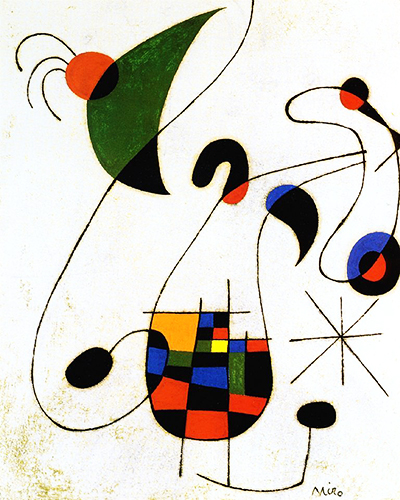Joan Miro's artwork is often dubbed childlike, owing to its colourful, solid composition. Joan Miro Article- Melancholic Singer makes one such exemplary piece, featuring multicoloured series of shapes.
The piece features an oddly large negative space where the painting of the picture can dance; it epitomises an imagery associated with a painter's irrepressible work of art, playing on a piece of canvas or sheet of paper. The painting has a series of broken images, overwhelming the negative space while the oft-used flat images associated with Miro's work feature a unique child-like form. The dominating yellow scribbles circling the organic forms exude Miro's oomph when painting this piece. It is an energy that allows audiences to join in Miro's ecstasy as their eyes move around the composition of the painting and the canvas.
Joan Miro's early artwork adopted an organic and flattened form of painting that was influenced by poets and writers in Paris. His interest in automatism and sexual signs dubbed him a Surrealist, though he rejected association with any artistic movement. Miro wanted to be free to experiment other artistic styles without conceding his position in the movement. He pursued his interests in art that ranged from surrealism and automatic drawing, colour field painting, expressionism and lyrical abstraction. While Miro's Melancholic Singer painting exhibited broken lines that are dancing across a negative space, it hardly demonstrated his characteristic style of painting. Influential pieces like The Farm, Harlequin's Carnival and The Tilled Field exhibited a rather solid composition, dominating the negative space.
Being a nationalist of some sort, Joan Miro's paintings always highlighted features of his native home Spain. The Tilled Field is an abstract illustration of the landscape of his home; Catalan. The painting highlights a radical departure from his previous style of childlike organic forms and the first work categorised as Surrealist. The complex arrangement of figures and objects makes The Tilled Field Miro's earliest Surrealist work of art. The painting displays a merry making fiesta known as Mardi Gras (a celebration that precedes the fasting of Lent and ends on the day before Ash Wednesday). The main character of the painting Harlequin frequently plays the guitar and falls prey to unrequited love. Art critics find the painting to be a depiction of human's subconscious mind. The Harlequin Carnival painting marks Miro's highest point on mimicking his unique surrealist style.
The Farm is Miro's favourite and the most famous painting; it shows the family's country house in Catalonia and summarises his early work before transitioning to surrealism. Miro later confessed that he wanted to put everything he loved about his home on the painting; from a huge tree to the tiny looking snail.
Born on 20th April 1893, in Barcelona, Spain, Joan Miro's early art exuded still-lifes, genre scenes and landscapes inspired by Paul Cezanne and Vincent Van Gogh. After his solo exhibition in Barcelona, Miro settled in Paris where he began working on paintings (such as The Farm) that highlighted a rather individualistic style of painting with certain patriotic qualities. In 1924, he joined the Surrealist group where Miro abandoned his chaotic and cluttered style, taking on the collage. The paintings were later dubbed Miro's dream paintings. Subsequent works like The Hunter showed rather intricate surrealistic styles of art that comprised curved lines for a moustache, a triangle for the head and angular lines for the rest of the body. So encoded was the work that Miro later provided an explanation of the signs used. Miro's later years saw him accelerate his work to different media, producing numerous ceramics like the Wall of the Sun and the Wall of the Moon. He also created glass window paintings for an exhibit and proposed the exploration of four-dimensional paintings and gas sculptures.




